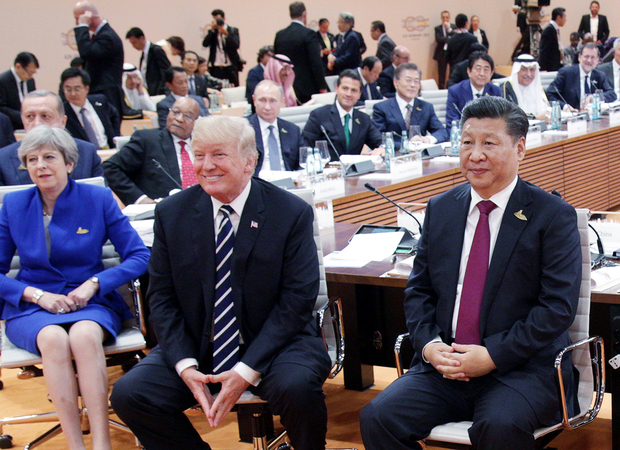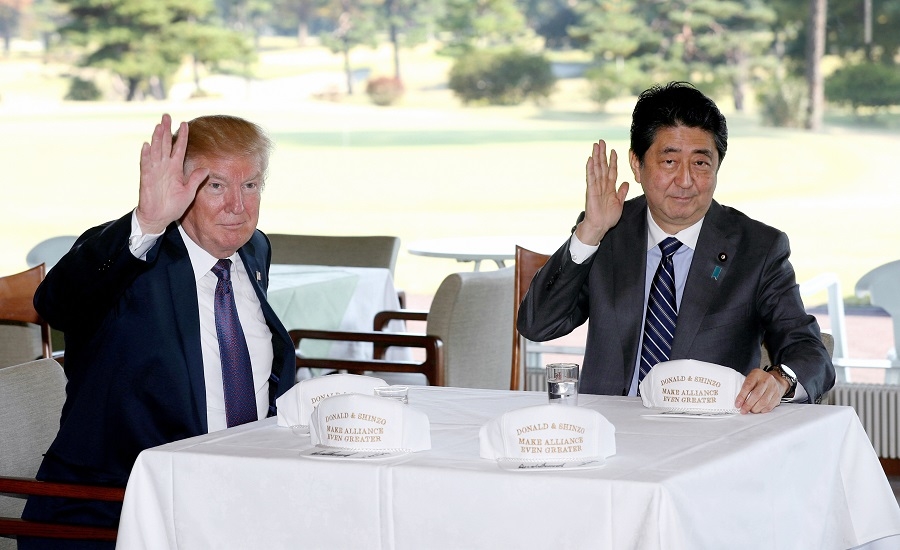Last Friday, Donald Trump embarked on a five-country tour of Asia where he’s visiting Japan, South Korea, China, Vietnam, and the Philippines. Orville Schell, Arthur Ross Director of the Center on U.S.-China Relations and ChinaFile’s publisher, is on the trip, on assignment for Vanity Fair. What follows is the first of a series of daily posts in which Schell reflects on what he’s seeing on the trip, in response to questions from our editors. The posts are compiled from those interviews and lightly edited.
Many are fearful that Xi Jinping’s ability to awe his visitors with over-the-top manifestations of pomp and ceremony will turn Donald Trump to Jell-o. But having watched Trump arrive in Japan yesterday on the first leg of his five-country trip, it’s clear he, too, understands a thing or two not just about the power of the U.S. military abroad (which is considerable, we have some 50,000 troops in Japan alone at myriad military bases), but the power of ceremony and how to use it to awe.
As Air Force One’s tires hit the runway in a puff of smoke, members of the press stood inside a huge hangar at Yokota Air Force Base just outside of Tokyo with several thousand American servicemen and women from the Air Force, Army, Navy, and hundreds of members of Japan’s military, the Self-Defense Force, as an audience. A stage had been set up in the hangar in front of an American flag so enormous it made the celebrated banner in the film Patton look like child’s play. For added dramatic effect, the base commander had brought in an F-16 and an F-35 fighter jet and positioned them so that both of their needle-shaped nose cones aimed right at the podium.
After Air Force One pulled up in front of the yawning mouth of the hangar and a ramp had been wheeled up against the fuselage of the giant plane, the forward door opened and Donald and Melania Trump emerged, he with his unmistakable (even from a distance) signature flaxen hair, like figurines from a cuckoo clock coming out to toll the hour. As they descended the stairs, they waved, a band struck up a John Philip Sousa march, and the troops roared. This was theater of the highest order. For him, it was like being at one of those presidential rallies he so passionately loves to hold among his adoring “base” as a way to invigorate himself with the kind of admiration he rarely quite gets from the press.
During his speech, which he read from a teleprompter, he was dignified and to-the-point, proclaiming that, “No one, no dictator, no regime, and no nation should underestimate ever American resolve.” The speech was a very clear affirmation of the need for the U.S. to be in Asia and of Japan as “a treasured partner and a crucial ally of the U.S.” in our network of Asian Allies. Again and again he returned to this idea of Japan and the U.S. as having a special alliance relationship.
Conversation
11.02.17
Trump Goes to Asia
What was so interesting about his affirmation of the U.S.-Japan alliance and America’s commitment to the “Indo-Pacific region” (a new term that expands the U.S. pretension of Pacific influence all the way to India) was that he seemed not just to be talking about North Korea and its mercurial leader, Kim Jong-un, but also to be indirectly also alluding to China. The threat of nuclearization of the DPRK allowed him to indirectly put China on notice that the U.S. military presence in Japan and elsewhere in Asia was also a hedge against China’s own rising and increasingly aggressive military posture in the South and East China Seas.
From Trump’s speech at Yokota and later at his joint press conference with Prime Minister Shinzo Abe at Akasaka Palace, as well as from talking to officials traveling with the President, it seemed evident that, despite his early complaints that Japan did not pay its way in its own security, he has at last understood the fundamental need for the U.S.-Japan security cooperation in an alliance that for decades had come to seem a very ho-hum thing, even anachronistic during the heady days of “engagement” optimism with China, and the Six-Party Talks with the DPRK. Now, however, our mutual security treaty with the Japanese was suddenly coming back to life in the most dramatic way, as a critical element of U.S. foreign policy. Trump and Abe have, in fact, seemed to generate a genuine appreciation of each other’s support. At his farewell press conference with Abe, Trump declared such effusive things as, “I believe that there never have been such close bonds,” “the U.S. and Japan are 100 percent together,” and “I am thrilled my first stop was with you.”
What is clear from watching Trump and Abe make such affirmations of the U.S.-Japan alliance and Trump’s declarations of deep friendship to Abe (which were equally as effusively returned in Abe’s remarks) is that there is a real courtship competition for Donald Trump’s affections now going on between Shinzo Abe and Xi Jinping. Not only are China and Japan locked in a conflict over the Senkaku/Diaoyu Islands, but they are fighting to see who will win the new American President’s most devoted attentions.
We’ll have to wait to see what happens when we get to Beijing, but for now I think Abe has done a very good job of winning over Trump. In my lifetime, I’ve not seen the U.S.-Japan alliance more highlighted, vital, and well-fortified than now. Their public displays of affection are perhaps best metaphorically encapsulated in the baseball-style cap (Trump’s specialty) that Abe gave Trump inscribed with: “Donald and Shinzo: Make Alliance Even Greater.” It will be more than interesting to see whether Xi’s courtship of Trump—unfortified by golf—can reach the same level of ecstasy.
What now seems to be getting challenged is the very idea of old-style “engagement.” There’s been a persistent idea over the last several decades that if the United States stuck with and embraced China, allowed it into the World Trade Organization, included it in the rules-based Western order, exchanged hundreds of thousands of students, invited more Chinese sports teams, ballet companies, orchestras etc. to perform, China would slowly become appreciative, more like us, more congenial, and less disruptive of the existing world order, as so-called “stake holders” that wanted to fit. In many ways that has not happened, and I think this idea doesn’t have as much hold on this current administration. At the same time, the attitude of the American public at large also seems to be slowly changing; the notion that animated the last few decades that the U.S. and China were on slowly converging, rather than diverging, trajectories, is no longer credible. The Chinese have been increasingly assertive, aggressive, and even provocative, and I think we are now seeing some blowback. This is all the more true after the 19th Party Congress and Xi’s declaration that we are in a “new era” where the U.S. is in decline and “socialism with Chinese characteristics” is in ascendancy. And, there now seems to be a growing sentiment, inside the Trump administration as well, that we have hit an inflection point, that it would be dangerous to continue to allow ourselves to be “played,” whether in trade, investment, cultural exchange, or military cooperation, by Beijing. I think this Asia trip will be a test of what kind of an inflection point we are actually now at with China, and what response is best suited of this “new era.”
In talking with U.S. officials, I think we can expect few important public deliverables from China at this summit. Perhaps more important, we should carefully watch what happens down the line after Trump returns to Washington, in terms of how the White House responds to the reality that, in too many ways, the playing field is out of level for Americans in China. Whether you’re a businessman, a media rep, a scholar, a civil society actor, or a religious leader, the notion of reciprocity is being sorely stretched. The U.S. has been open to China, while China has been increasingly closed to us. In the weeks going forward, it would not surprise me to see the Trump Administration, despite all the niceties of Trump’s Mar-a-Lago friendship with Xi, begin to play a much harder, even confrontational, game with China in ways that may surprise us.
We’ll learn more in Seoul and then finally in Beijing. But it is no accident—as Trump pointed out to Abe at the joint press briefing—that his great hegira to Asia did not begin in Beijing, but in Tokyo and Seoul.




